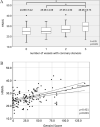Non-mercaptalbumin is significantly associated with the coronary plaque burden and the severity of coronary artery disease
- PMID: 34244579
- PMCID: PMC8270939
- DOI: 10.1038/s41598-021-93753-0
Non-mercaptalbumin is significantly associated with the coronary plaque burden and the severity of coronary artery disease
Abstract
Human non-mercaptalbumin (HNA), oxidized form of serum albumin, has been reported as a useful marker in oxidative stress-related diseases; however, few reports have examined the association between HNA and the severity of coronary artery disease (CAD). The present study evaluated whether the HNA fraction is correlated with coronary artery stenosis in 140 patients considered to have a high risk of CAD or who were suspected of having acute coronary syndrome. The severity of CAD was defined by the number of stenotic coronary vessels and a severity score system (the Gensini score). HNA measurements were performed using our newly established high-performance liquid chromatography methodology. The results had shown that HNA was significantly increased in patients with three-vessel disease, compared with those without CAD or with single-vessel disease (p = 0.025), and was positively correlated with the Gensini score (ρ = 0.421, p < 0.001). A multivariate analysis showed that the number of stenotic vessels was an independent and significant factor associated with HNA (ρ = 1.246, p = 0.012). A logistic regression analysis showed that HNA was a strong predictor of multivessel CAD (odds ratio, 1.12; 95% confidence interval, 1.020-1.229; p = 0.017). These findings indicate that the measurement of HNA could be clinically practical for predicting the severity of coronary artery stenosis.
© 2021. The Author(s).
Conflict of interest statement
The authors declare no competing interests.
Figures



Similar articles
-
White-coat hypertension during coronary computed tomography angiography is associated with higher coronary atherosclerotic burden.Coron Artery Dis. 2017 Jan;28(1):57-62. doi: 10.1097/MCA.0000000000000424. Coron Artery Dis. 2017. PMID: 27580089
-
Relationship of exercise to coronary artery disease extent, severity and plaque type: A coronary computed tomography angiography study.J Cardiovasc Comput Tomogr. 2019 May-Jun;13(3):34-40. doi: 10.1016/j.jcct.2019.02.001. Epub 2019 Feb 27. J Cardiovasc Comput Tomogr. 2019. PMID: 30837117
-
Diffuse coronary artery disease among other atherosclerotic plaque characteristics by coronary computed tomography angiography for predicting coronary vessel-specific ischemia by fractional flow reserve.Atherosclerosis. 2017 Mar;258:145-151. doi: 10.1016/j.atherosclerosis.2017.01.018. Epub 2017 Jan 16. Atherosclerosis. 2017. PMID: 28168977 Free PMC article.
-
Prognostic Implications of Plaque Characteristics and Stenosis Severity in Patients With Coronary Artery Disease.J Am Coll Cardiol. 2019 May 21;73(19):2413-2424. doi: 10.1016/j.jacc.2019.02.060. J Am Coll Cardiol. 2019. PMID: 31097161
-
Serial coronary computed tomography angiography-verified coronary plaque progression: comparison of stented patients with or without diabetes.Cardiovasc Diabetol. 2019 Sep 24;18(1):123. doi: 10.1186/s12933-019-0924-z. Cardiovasc Diabetol. 2019. PMID: 31551077 Free PMC article.
Cited by
-
A simple colorimetric assay to determine the concentration and proportion of human mercaptalbumin.Pract Lab Med. 2022 May 23;31:e00281. doi: 10.1016/j.plabm.2022.e00281. eCollection 2022 Aug. Pract Lab Med. 2022. PMID: 35711386 Free PMC article.
References
Publication types
MeSH terms
Substances
LinkOut - more resources
Full Text Sources
Miscellaneous

